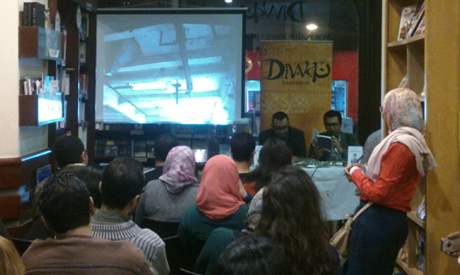
Wagdy El-Komy reading anthologies from his book (Photo: Mohammed Saad)
Khanadiq Al-Aazrawat (The Trenches of the Virgins), by: Wagdy El-Komy, Beirut: Dar Al-Saqi. 2013. 208pp.
Before heading to Zamalek's Diwan bookstore on Sunday 1 Dec for the book signing and discussion of journalist Wagdy El-Komy's latest novel Khanadiq Al-Aazrawat (The Trenches of the Virgins), some audience members contacted the venue to confirm that the event had not been cancelled due to the violent clashes that erupted between security forces and angry pro-Morsi protesters attempting to enter the nearby Tahrir Square.
In an attempt to ease the audience's apprehension and demonstrate the correlation between current events and his book, the author asserted that, as a realistic writer, his interest lies in facts and realities -- especially historical events with deep impact on people's lives. His novel, a case in point, explores the rampant corruption which characterised ousted president Hosni Mubarak's times.
“In every novel, I try to mix between the present, the real, and historical events; it’s more like connecting the present with its similar past. This country has been subject to continuous plundering for decades. I tried to look for a theme that would explain and contextualise this ongoing robbery,” El-Komy said.
This is the author's second release since the 25 January Revolution. The first was a short story collection titled Seven Attempts to Jump Over a Siege, released by Shorouk Publishing House; the second, The Trenches of the Virgins, El-Komy preferred to entrust to Al-Saqi Publishing House in Beirut due to the poor publishing conditions afflicting Egypt since the revolution.
The novel is set in an abandoned beer factory, constructed in 1897 opposite Cairo University. To substantiate his work, Wagdi conducted research on the factory, extensively visited the site, and gathered real accounts from neighbouring residents.
“I used to imagine secret tunnels and trenches concealed within the factory. On my actual visit, I found them and walked through one; the others, although only five metres long, seemed forbidding. I relied on a German historian's research for additional information about the factory. The mythical stories I heard from the people in the neighbourhood were deeply interesting,” El-Komy said, declining to reveal the details contained in the novel.
The writer also spoke of his experience as editor of his newspaper's crime section. “I like the crime pages a lot. They are interesting, fun, and provide a very enriching experience.”
Despite the author's repeated assertions of his realistic, historical writing style, he believes a writer should nonetheless add a fictional sense to the material, rather than confining himself within the borders of realism.
“By creating my own language, I express what I want while avoiding easy sentences and clichés. I also try to write in the language used within the historical context I am depicting,” he said.
Author of Death Likes It Black, El-Komy stated that his preference for realistic novels does to exclude his openness to all literature, as each literary form caters to its own audience.
Wagdy El-Komy, 33, is the News Desk editor and ex-culture editor at the Egyptian daily Youm7. He released three novels and one short story collection. He graduated from the Cairo University's Faculty of Antiquities.
Short link: